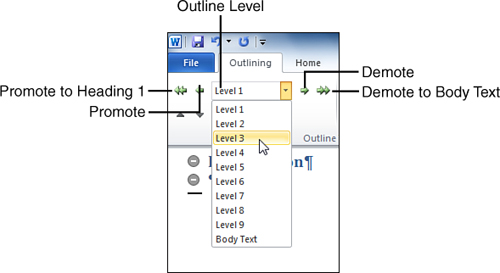Building an Outline
Creating an outline is a lot like creating a normal
document: just start typing. When you’re in Outline view, however, you
need to type only the document’s headings, and Word automatically
formats them. When you press Enter at the end of a heading, Word
creates a new paragraph formatted with the same heading level. You can
promote any heading to a higher level or demote it to a lower
(subordinate) level. You can also reorganize an outline by dragging
headings, and expand or collapse sections that are divided into
subsections.
Adding Headings to an Outline
Here’s how to start building an outline. All the
headings will be the same level, but you’ll learn to change heading
levels in the next section.
1. | Open a new, blank document, just to keep things tidy. |
2. | On
the Home tab, click Show/Hide ¶ (if necessary) so that you can see
paragraph marks and other nonprinting characters. These characters can
help you keep track of things in your outline, so it’s a good idea to
display them.
|
3. | Switch to Outline view, as described in the previous section. The insertion point appears at the first blank paragraph.
|
4. | Type
your first heading; then press Enter. Word formats the paragraph as a
level 1 heading (by applying the Heading 1 style). The insertion point
jumps down to a new paragraph, which also is formatted as a level 1
heading, as shown in Figure 3.

|
5. | Type a few more headings, pressing Enter after each one. When you finish, you should have a bunch of level 1 headings.
|
Promoting and Demoting Headings
Word supports nine heading levels, and you can assign any level to any heading. To do this, you can promote the heading to a higher level (say, from level 3 to level 2) or demote it to a lower level (for example, from level 1 to level 2). Here’s how:
1. | In your outline, click the heading you want to change.
|
2. | On the Outline tab, do one of the following:
- To promote the heading to a higher level, click the Promote button.
- To demote the heading to a lower level, click the Demote button.
In
either case, clicking the button once promotes or demotes the heading
by one level. You may need to click multiple times to reach the desired
level. |
3. | Repeat steps 1 and 2 for any other heading you want to promote or demote.
|
Aside from using the Promote and Demote buttons, you can change a heading’s level in the following ways:
- To promote a heading one level, press Tab or Alt+Shift+Right Arrow.
- To demote a heading one level, press Shift+Tab or Alt+Shift+Left Arrow.
- To promote any heading all the way to the highest level, click Promote to Heading 1.
- To demote any heading all the way down to body text, click Demote to Body Text.
- To
avoid some of the clicking, select a heading, click the Outline Level
drop-down arrow, and then click the desired level, as shown in Figure 4.
